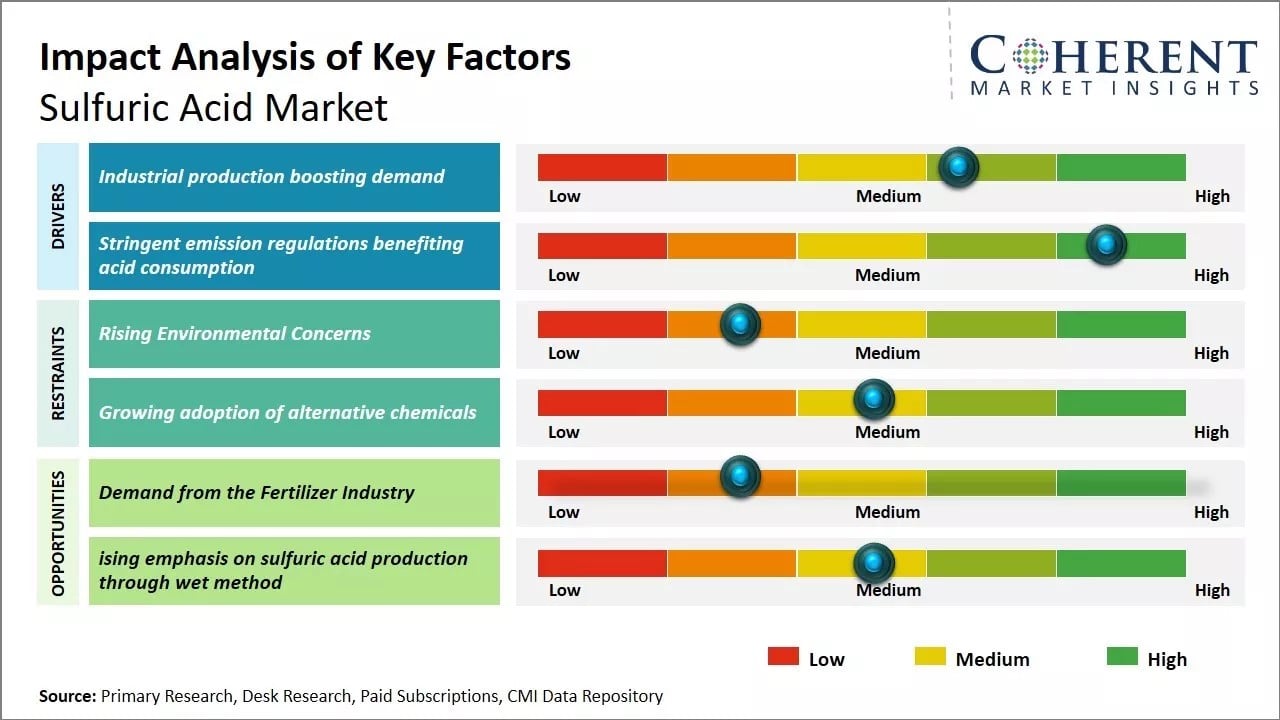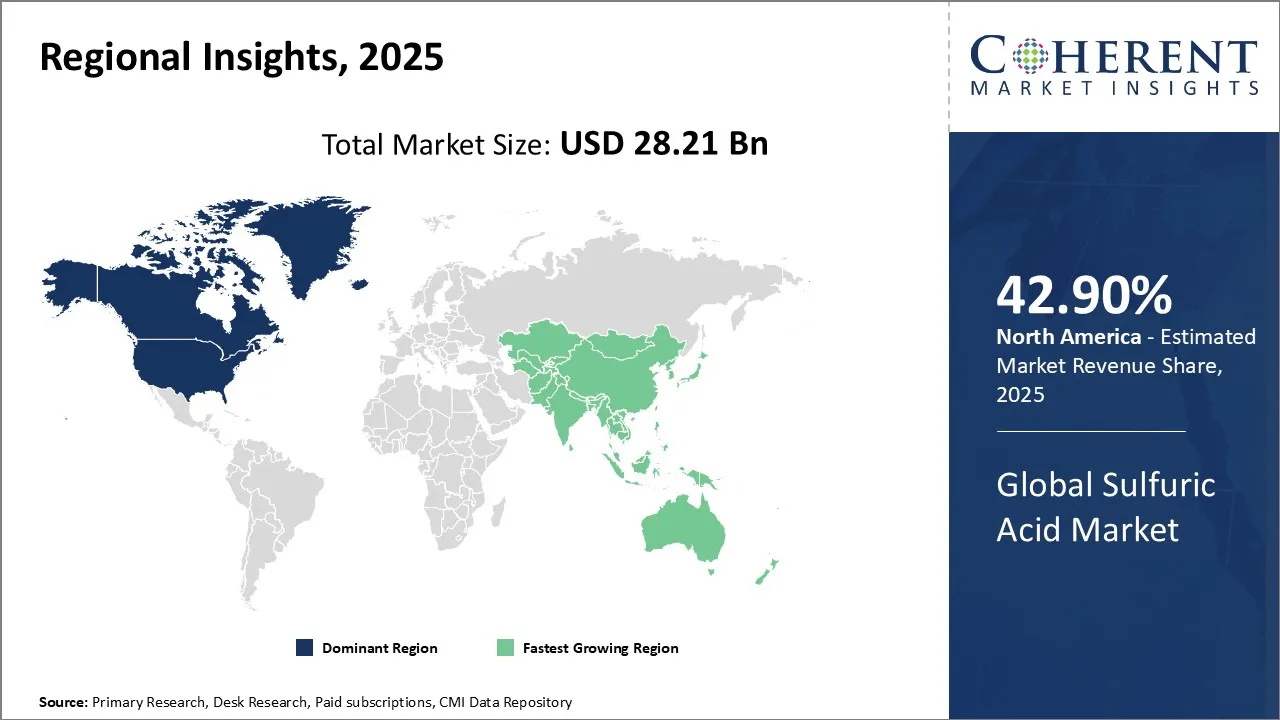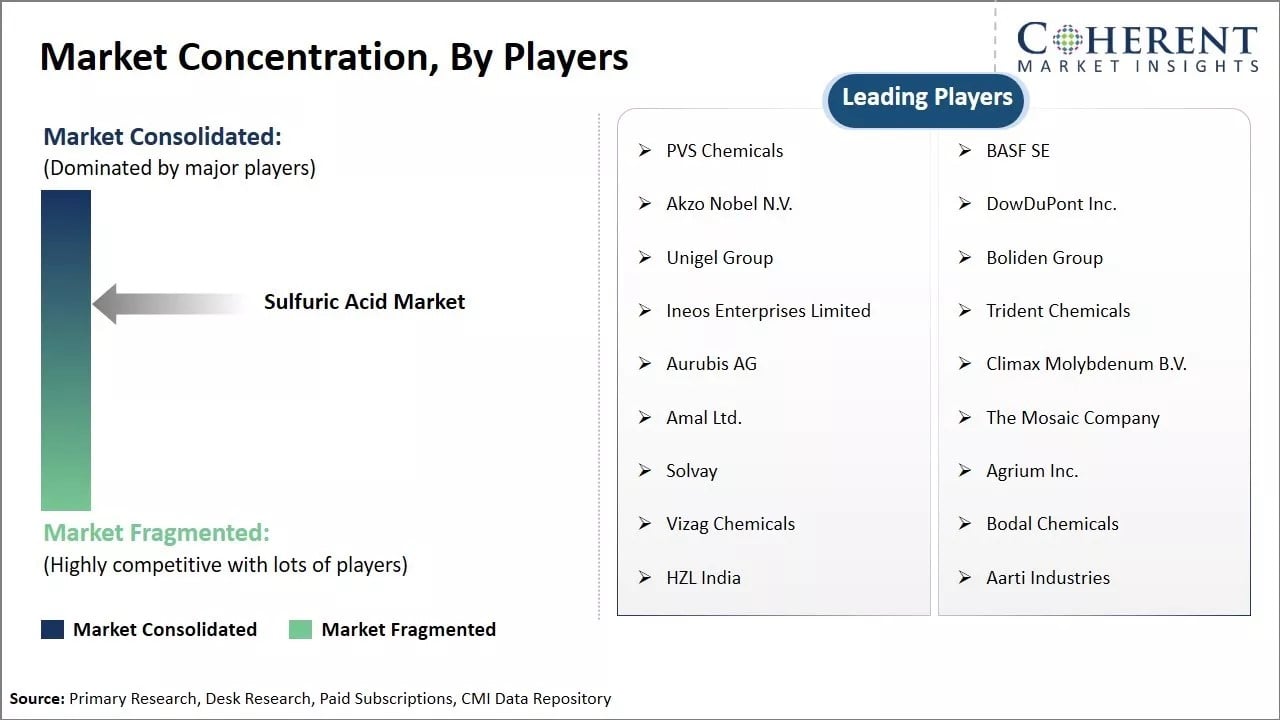The sulfuric acid market is estimated to be valued at USD 28.21 Bn in 2025 and is expected to reach USD 39.46 Bn by 2032, growing at a compound annual growth rate (CAGR) of 4.9% from 2025 to 2032.

To learn more about this report, Download Free Sample
The demand for sulfuric acid is expected to grow steadily due to its increasing applications in chemical manufacturing industries. It is primarily driven by the growing demand from the fertilizer industry as the world's population is rising. Also, recovery in manufacturing and construction sectors will further contribute to the growth of the sulfuric acid market during the forecast period.
|
Current Event |
Description and its Impact |
|
Electric Vehicle Battery Manufacturing Boom |
|
|
Fertilizer Industry Demand Fluctuations |
|
Uncover macros and micros vetted on 75+ parameters: Get instant access to report
In terms of raw material type, elemental sulfur segment contributes 52.1% share of the market owing to its relatively low production cost compared to other raw materials. Elemental sulfur is readily available from various industries as a byproduct, making it inexpensive to obtain. It requires less processing than pyrite ore to produce sulfuric acid, avoiding the need for expensive smelting and roasting steps.
Additionally, the wet contact process used for elemental sulfur conversion has relatively simple equipment and produces fewer waste emissions compared to other production methods. These cost advantages allow sulfuric acid producers to offer competitive prices while still maintaining healthy profit margins when using elemental sulfur as the raw material. The bulk availability and low costs associated with elemental sulfur give it an edge over other materials like pyrite ore in the price-sensitive sulfuric acid market.
For instance, in November 2025, Elessent Clean Technologies' acquisition of Sulphurnet is good news as this will help make sulfuric acid in a more environmentally friendly way. Sulphurnet's knowledge of filtration and process optimization improves efficiency, lowers the impact on the environment, and helps industries like mining and fertilizers. This strategic move helps Elessent grow its global presence and encourages innovation and resilience in sulfur-based chemical value chains.
In terms of application, fertilizers segment contributes 41.6% of the market share due to sulfuric acid's widespread use in fertilizer production. Sulfuric acid serves as the raw material for most sulfate fertilizers like ammonium, potassium, and superphosphates. It reacts with phosphate rock to produce phosphoric acid, a key compound in many fertilizer formulations. Given the vast global demand for fertilizers to support agriculture, any disruption in sulfuric acid supply would impact food security. Producers therefore prioritize reliable sulfuric acid allocations to fertilizer customers.
Additionally, favorable regulations in major markets promote fertilizer usage. Subsidies and policies in countries like China, India, and Brazil encourage fertilizer adoption amongst farmers. This growing fertilizer consumption directly correlates to higher sulfuric acid volumes absorbed by the fertilizer application segment. The essential role that sulfuric acid plays in meeting humanity's nutritional needs tilts the scales in favor of the fertilizer segment.
For instance, in December 2025, Hindalco Industries has won India's sulfuric acid tender, becoming the L1 bidder to provide a major fertilizer company. The contract makes sure that CFR Cochin continually has acid available. This helps make fertilizers, keeps demand steady, and makes India's agricultural and chemical industries more resilient.
In terms of manufacturing process, the wet contact process segment contributes the highest share of the market owing to its cost competitiveness and relatively cleaner emissions profile. The wet contact process entails burning sulfur vapor in air towers to produce sulfur trioxide gas, which is then absorbed in sulfuric acid. While requiring large contact towers, its equipment costs are lower than the expensive lead chambers of the lead chamber process. It avoids using toxic heavy metals and produces less bottom waste than alternative processes.
Additionally, the wet process yields higher conversion efficiencies at lower operating costs due to improved mass transfer relative to single contact. This enhances profits for sulfuric acid producers. Stringent environmental regulations in major markets also favor its relatively cleaner emissions. Wet contact has thus gained broader acceptance due to the favorable balance it strikes between production costs, conversion efficiency, and sustainable operations.

To learn more about this report, Download Free Sample
North America has dominated the global sulfuric acid market for the past few decades with 42.9% of the market share. The region accounts for the largest market share due to a strong presence of chemical and fertilizer industries which are the major end users of sulfuric acid. The U.S. is the single largest country-level market owing to the presence of many acids consuming industries.
Moreover, the country remains one of the top producers of the chemical aided by the easy availability of key raw materials. Many international players have established their production facilities in the region to cater to the local demand. This has further boosted the domestic manufacturing of sulfuric acid.
For instance, in April 2025, Technic Inc., which is based in Cranston, Rhode Island, launched with Technistan ECO Acid, a safer 9M sulfuric acid solution for tin electroplating. It takes the place of dangerous 18M sulfuric acid, making bath management easier, protecting brighteners, and adding built-in antioxidant protection. The new idea makes global manufacturing safer, more efficient, and better at plating.
Asia Pacific has emerged as the fastest growing regional market for sulfuric acid in recent years. China accounts for the major share of both production and consumption in the region. The country has witnessed a rapid growth in the manufacturing sector involving industries like chemicals, fertilizers, and petrochemicals. This has translated into a burgeoning demand for sulfuric acid.
Moreover, the Chinese government has actively promoted self-sufficiency in fertilizer production to boost agricultural yields. As a result, domestic sulfuric acid manufacturing has increased substantially to meet the escalating demand from fertilizer plants. Apart from China, India is another high growth market attributed to robust industrial development. The South Asian nation has also witnessed major capacity additions in sulfuric acid plants over the last decade.
For instance, in June 2025, S&P Global Platts announced it planned to alter the way it rates sulfuric acid in Asia. The update changes how sulfuric acid prices are reported, which affects price benchmarks in all Asian markets. The goal of these changes is to make it easier to see, understand, and keep track of sulfuric acid trade flows in the area.
The U.S. needs sulfuric acid since it is so important for making fertilizers, chemicals, refining oil, and processing metals. Growing agriculture, industry, and energy needs keep consumption going. Sulfuric acid is very important for America's economy and industry due to it can be used in many different ways in the automotive, pulp and paper, and textiles industries.
For instance, in March 2025, Ecovyst Inc. announced it acquired Cornerstone Chemical Company's sulfuric acid assets, which would allow it grow its business along the U.S. Gulf Coast. The deal helps Ecovyst make and supply more products, which helps the refining and chemical industries. This strategic move improves infrastructure, efficiency, and market presence in sulfuric acid, which is important for industrial growth.
The need for sulfuric acid in Thailand comes from its use in making chemicals, fertilizers, refining oil, and processing metals. The country's growing agricultural sector, expanding industries, and dependence on refining and the automotive industries all contribute to fuel consumption. Sulfuric acid is very important for Thailand's economic and industrial growth because it can be used in so many different ways.
For instance, in May 2025, Sumitomo Corporation formed a joint venture with Thailand-based tank terminal operator NFC Public Company Limited to operate a sulfuric acid tank terminal. By acquiring a strategically located terminal and applying its expertise in sulfuric acid terminal operations, Sumitomo aims to improve safety and logistics reliability while establishing a regional hub to support business expansion across neighboring Asian markets.
| Report Coverage | Details | ||
|---|---|---|---|
| Base Year: | 2024 | Market Size in 2025: | USD 28.21 Bn |
| Historical Data for: | 2020 To 2024 | Forecast Period: | 2025 To 2032 |
| Forecast Period 2025 to 2032 CAGR: | 4.9% | 2032 Value Projection: | USD 39.46 Bn |
| Geographies covered: |
|
||
| Segments covered: |
|
||
| Companies covered: |
PVS Chemicals, BASF SE, Akzo Nobel N.V., DowDuPont Inc., Unigel Group, Boliden Group, Ineos Enterprises Limited, Trident Chemicals, Aurubis AG, Climax Molybdenum B.V., Amal Ltd., The Mosaic Company, Solvay, Agrium Inc., Vizag Chemicals, Bodal Chemicals, HZL India, and Aarti Industries |
||
| Growth Drivers: |
|
||
| Restraints & Challenges: |
|
||
Uncover macros and micros vetted on 75+ parameters: Get instant access to report
The global sulfuric acid market is closely tied to industrial production levels around the world. Being a bulk chemical with widespread applications, sulfuric acid acts as an important intermediate in the production of numerous chemicals, fertilizers, and other materials. When industrial activities are high, the manufacturing of these downstream products increases rapidly, in turn, driving up demand from sectors such as fertilizers, chemical processing, oil refining, wastewater treatment, and metal processing among others. In recent years, the recovery in global industrial production after the recessionary phase has stimulated significant growth in consumption of sulfuric acid. Particularly, robust capital expenditures in developing economies on expanding domestic manufacturing capabilities has translated to greater sulfuric acid intake. The construction sector has also improved gradually, benefitting the fertilizer industry where sulfuric acid is a core ingredient.
Growing environmental awareness as well as technological progress are compelling industries towards lowering their carbon footprint and turning greener. Sulfuric acid especially finds increased applicability in meeting emission standards getting stricter by the year. Desulfurization of fuel represents one of its primary application areas presently. Sulfur presents in crude oil and needs removal to manufacture ultra-low sulfur gasoline and diesel mandated under legislation. Sulfuric acid aided hydrodesulfurization allows refiners to reduce sulfur content in transport fuels to extremely low permissible limits. With emission norms being tightened further, including recent IMO regulation capping marine fuel sulfur, the demand for desulfurization is anticipated to rise sharply in the coming years.

To learn more about this report, Download Free Sample
Share
Share
About Author
Yash Doshi is a Senior Management Consultant. He has 12+ years of experience in conducting research and handling consulting projects across verticals in APAC, EMEA, and the Americas.
He brings strong acumen in helping chemical companies navigate complex challenges and identify growth opportunities. He has deep expertise across the chemicals value chain, including commodity, specialty and fine chemicals, plastics and polymers, and petrochemicals. Yash is a sought-after speaker at industry conferences and contributes to various publications on topics related commodity, specialty and fine chemicals, plastics and polymers, and petrochemicals.
Missing comfort of reading report in your local language? Find your preferred language :
Transform your Strategy with Exclusive Trending Reports :
Frequently Asked Questions
Joining thousands of companies around the world committed to making the Excellent Business Solutions.
View All Our Clients